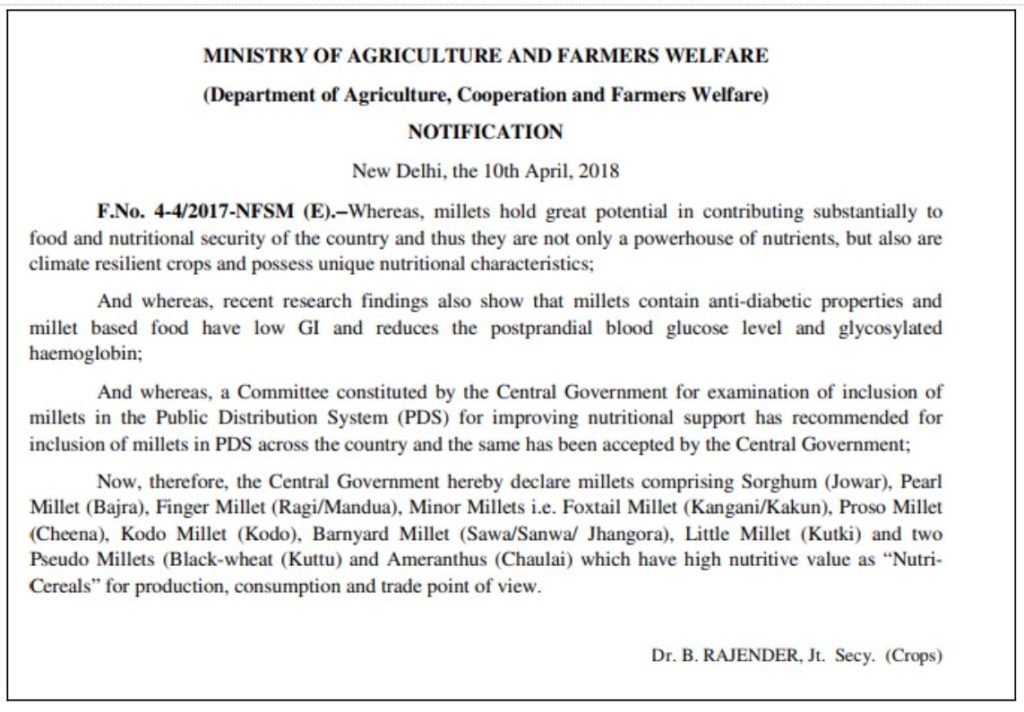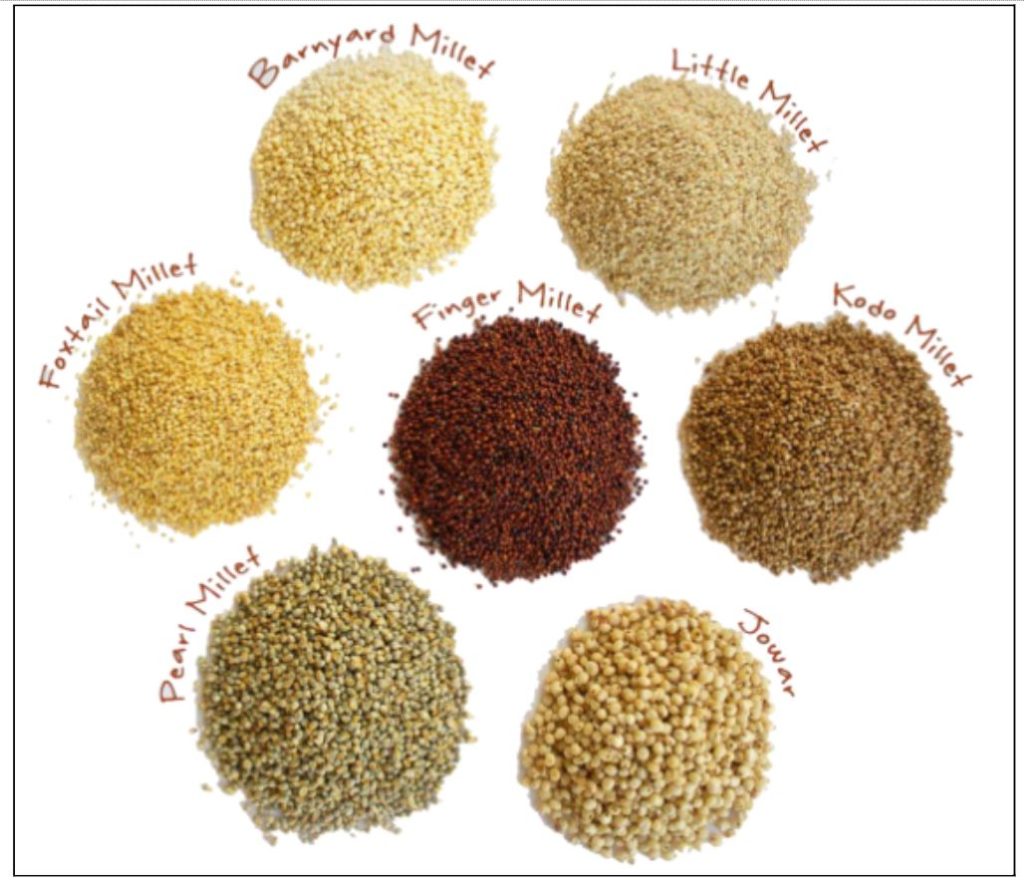The year 2023 is declared the ‘International Year of Millets’ by the UN, following India’s proposal. India has earlier observed the year 2018 as the ‘National Year of Millets’. Here is everything you need to know about Millets and the activities being planned.
Accepting the Indian government’s proposal, the year 2023 has been declared the International Year of Millets by the 75th session of the United Nations General Assembly. The declaration is aimed at spreading awareness on the contribution of millets to food security and nutrition while also scaling up the sustainable production and quality of millets. At a time when the global agrifood systems are faced with challenges to feed an ever-growing global population, millets are resilient cereals that can help overcome the challenges. In this story, we look at what millets are, their benefits, and what all actions are being taken to achieve the objectives in this ‘Year of Millets’.
Millets are the traditional food in Asia and Africa
According to Food and Agriculture Organization (FAO), millet is a collective term referring to a number of small-seeded annual grasses that are cultivated as grain crops, primarily on marginal lands in dry areas in temperate, subtropical and tropical regions. These crops are mainly grown in developing countries as a subsistence crop for local consumption. Major millet crops in India include Jowar or Sorghum, bajra or pearl millet, ragi or finger millet, kangni or foxtail millet, sama or little millet, kodo, barnyard and proso millets.
Millets are considered traditional food for more than half a billion people across Asia and Africa. Currently, millets are being grown in 130+ countries. In India, Millets are primarily kharif crops and require lesser water and agricultural inputs compared to rice and wheat. They have the potential to address multiple Sustainable Development Goals (SDGs).
Millets have nutritional, ecological, and economic benefits
In terms of nutritional value, millets are very good sources of carbohydrates, dietary fibre, micronutrients, and phytochemicals with nutraceutical properties. They significantly contribute to human and animal diets owing to their high levels of energy, calcium, iron, zinc, lipids, and high-quality proteins. Millets contain 7-12% protein, 2-5% fat, 65-75% carbohydrates and 15-20% dietary fibre. As compared to the staple crops of rice and wheat, numerous studies have pointed out how millets are nutritionally superior. For instance, the calcium content in ragi or finger millet is 10 times higher than that of wheat or rice. Millets have a low Glycaemic Index (GI) which is also associated with the prevention of diabetes and are gluten-free.
Millets are sustainable crops. They have a low water and carbon footprint. According to ICRISAT, one rice plant requires nearly 2.5 times the amount of water required by a single millet plant of most varieties. Moreover, millets can grow on relatively poor soils and under adverse and arid conditions, with less fertilizer and irrigation requirements than other cereals. These crops have good resistance to pests and diseases. Not only does this help contribute towards combating climate change and food security, but also has the potential to generate livelihoods and increase farmers’ income.
Green revolution is one of the reasons behind decline in consumption of millets
Millets were among the first crops to be domesticated in India. There are several evidences of its consumption during the Indus valley civilization. However, in the 1960s, Green Revolution focused on grains like rice and wheat in place of millets to attain food security which resulted in the decline in consumption and production of millets in the country. Before the Green Revolution, millets made up around 40% of all cultivated grains, which dropped to around 20% over the years, and cultivation of commercial crops, oilseeds, pulses, and maize took over instead as market-oriented agriculture gained prominence.
Nonetheless, in the last decade, the focus is realigning towards mainstreaming millets in India. This is evident in terms of various policy interventions by governments.
Measures are being taken to mainstream millets in India
The National Agriculture Policy of 2000 focused on increasing production and productivity of crops to meet the increasing demand for food. One of the measures taken alongside boosting production of wheat and rice was a Centrally Sponsored Scheme – Integrated Cereals Development Programme in Coarse Cereals Based Cropping Systems Areas (ICDP-Coarse Cereals). (Millets were referred to as Coarse Cereals). In 2011-12, the Government launched the Initiative for Nutritional Security through Intensive Millets Promotion (INSIMP) to increase area, productivity, and production of millets. It was later merged as component of National Food Security Mission (NFSM) as NFSM-Coarse Cereals from 2014-15.
In about a year, in 2013, the National Food Security Act, 2013 came into effect which covers subsidy on coarse grains alongside rice and wheat.
In 2018, the Union Government issued a circular stating that millets be referred to as ‘nutri-cereals’ for production, consumption, and trade purposes. It also added that millets would be added to the Public Distribution System in the country following the recommendations of a committee set up by the government.

2018 was National Year of Millets
India also declared the year 2018 as the ‘National Year for Millets’ to promote millets for nutrition security. India had also sent a proposal to the UN for declaring 2023 as year of millets. This proposal was supported by 72 countries and the Food and Agricultural Organization and UNGA declared 2023 as International Year of Millets in March 2021. The Government of India also provided USD 5,00,000 to Food & Agricultural Organisation (FAO) to support the activities related to International Year of Millets – 2023.
Simultaneously, State Governments like Tamil Nadu, Telangana, Andhra Pradesh, Odisha, Madhya Pradesh, Gujarat, etc. also came up with their own policy interventions to revive millets.
India is leading producer and exporter of millets
In her budget speech for 2023-24, Finance Minister announced that India is the largest producer and second largest exporter of millets. With India at the forefront of celebrating 2023 as Year of Millets and promoting millets, there is a potential to create large international markets for Indian millets. India aims to create both domestic & global demand of millets, focusing on strategies to enhance climate resilient Nutri-cereals production, consumption, export, branding etc. Reports suggest that India is also leveraging its G-20 Presidency to promote millets.
In order to create awareness about millets within the country, the government has rolled out several campaigns ranging from millet food festivals in the parliament, releasing recipe books, organizing quizzes, caption and recipe competitions, among others.



